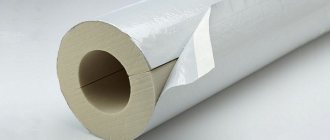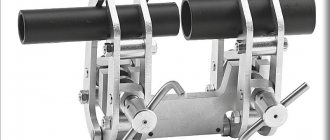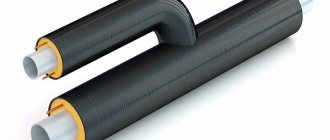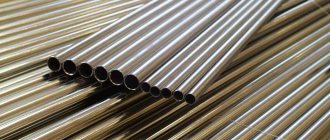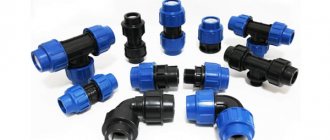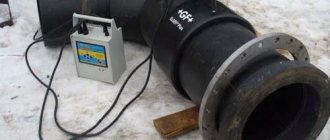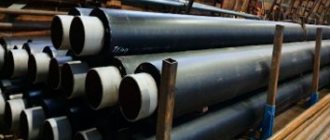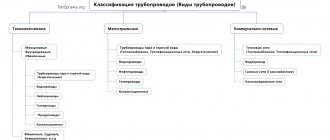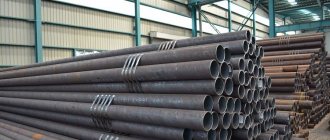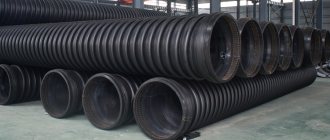The PPU shell is a semi-rigid (rigid) cylindrical product made of low-density polyurethane foam, which provides insulation, and, more precisely, thermal insulation of various pipelines. Such insulation is considered the most effective for pipes with coolant or products of the petrochemical industry. Technical parameters of the state of channels with PPU insulation are continuously monitored by the UEC (operational remote monitoring) system.
The so-called “shell” made of polyurethane foam is used for thermal insulation of pipelines for various purposes.
Design features of the insulating polyurethane foam shell
Structurally, polyurethane foam shells are half-cylinders one meter long, the internal diameter of which corresponds to a similar parameter of the insulated pipelines.
Note! To facilitate installation work, the products are equipped with locking longitudinal and transverse elements, which ensure the tightest possible connection.
The density of polyurethane foam is approximately 60 kg/m3, which greatly simplifies the assembly and transportation of shells for pipe insulation. Such thermal insulation is attached using glue or foam, as well as iron ties. To insulate a pipeline with a bend, corner elements are used.
For the production of heat-insulating polyurethane foam polyurethane foam shells for pipes, molds are used. Depending on the operating conditions, such products can be manufactured with an auxiliary coating of galvanized steel, aluminum foil, mastic, reinforced foil or fiberglass. Such protective layers increase the characteristics of deformation and mechanical strength, and also increase the service life of the insulation shell.
The shell has a rigid structure and consists of two parts for ease of installation
Necessary properties and requirements for shells for pipe insulation
Shell insulation with a lock for fastening to the pipe
The shell for pipes is a cylinder, cut on one side, or segments fastened together according to the tongue-and-groove principle. Insulation without grooves can be fixed using clamps, wire, or glue. After fastening, a protective casing is formed on the surface of the pipe.
Curved elements are provided for insulating tees, branches, bends, and junction angles. To connect the shell along its length, a separate shaped element is used - a coupling.
Such communication protection does not insulate, but avoids heat dissipation or heating due to high ambient temperatures.
The shell must match the diameter of the pipeline on which it will be mounted. The material from which the insulation is made must be resistant to low and high temperatures.
Basic requirements for thermal insulation for pipes:
- long service life;
- easy installation;
- low thermal conductivity;
- resistance to mechanical stress;
- protection against burns due to accidental touch;
- biological and chemical passivity;
- ability to maintain a constant coolant temperature.
Main product dimensions
The characteristics and dimensions of heat-insulating polyurethane foam shells for pipes are presented in the technical specifications (5758-019-01297858-01) for the products. According to the document, the internal diameter of products can be: 142.0; 122.0; 102.0; 92.0; 82.0; 72.0; 63.0; 53.0; 42.6; 32.5; 27.3; 21.9; 15.9; 13.3; 10.8; 8.9; 7.6 and 5.7 centimeters. The length of the heat-insulating polyurethane foam shell varies from 100 to 200 cm, but it can be changed by agreement with the customer.
The thickness of the product must be equal to the same parameter of the insulated layer of pipes and is selected from the table.
Table 1
| External section of steel pipes, cm | Thickness of shell-insulation for pipes, mm |
| 5,7 | 38,5 |
| 7,6 | 39,0 |
| 8,9 | 42,5 |
| 10,8 | 43,0 |
| 13,3 | 54,5 |
| 15,9 | 38,6 |
| 21,9 | 43,1 |
| 24,5 | 49,4 |
| 27,3 | 57,2 |
| 32,5 | 55,5 |
| 42,6 | 58,2 |
| 53,0 | 40,2 |
| 53,0 | 78,9 |
| 63,0 | 72,5 |
| 82,0 | 72,4 |
| 92,0 | 74,4 |
| 102,0 | 70,4 |
| 122,0 | 60-100 |
| 142,0 | 60-100 |
At the request of customers and design feasibility, the thickness of the thermal insulating shells of polyurethane foam can be changed.
Insulation can be made for both standard and non-standard size pipes
The radial angle of products with a diameter of 5.7-53.0 cm inclusive is 180 degrees; 63.0-82.0 cm inclusive – 120 degrees; for pipes with a cross section of more than 82.0 cm - 90 degrees. The geometric characteristics of polyurethane foam shells that heat-insulate pipelines may have deviations shown in the table.
table 2
| Name of geometric characteristic | Name of parameter deviation | Value of maximum deviations |
| Outside diameter | Deviation along the outer section of the shell, mm | +5 |
| Length | Length deviation, mm | ±10 |
Scroll
regulatory documents referenced in these specifications
1. SNiP 2.04.14-88 “Thermal insulation of equipment and pipelines.”
2. GOST 12.1.005-88. SSBT. “General hygienic requirements for the air in the working area.”
3. GOST 12.1.007-76*. SSBT. Harmful substances. Classification and general safety requirements.
4. GOST 12.4.010-89. The suit is cotton. Technical conditions.
5. GOST 12.4.011-89. Cotton mittens. Technical conditions.
6. GOST 12.4.021-75. SSBT. Ventilation systems. General requirements.
7. GOST 12.4.121-83*. SSBT. "Industrial filter gas masks." Technical conditions.
8. GOST 12.4.013-85E. Safety glasses. Technical conditions.
9. GOST 17.2.3.02-78. Protection of Nature. Atmosphere. Rules for establishing permissible emissions of harmful substances by industrial enterprises.
10. GOST 2010-93. Latex gloves. Technical conditions.
11. GOST 17177-94. Heat-insulating construction materials and products. Control methods.
12. GOST 20869-75. Rigid cellular plastics. Method for determining water absorption.
13. GOST 25880-83. Heat-insulating construction materials and products. Packaging, labeling, transportation and storage.
14. GOST 30732-2001. Steel pipes and fittings with thermal insulation made of polyurethane foam in a polyethylene shell.
15. TU 17-06-52-79. Protective low shoes made of synthetic leather with rubber soles.
16. “Rules for the transportation of goods in direct, mixed railway and water traffic”, M., “Transport”, 1985.
17. “Rules for the transportation of goods by road”, M., “Transport”, 1984.
TU 5768-019-01285878-01
Page 14
18. “Sanitary rules for the organization of technological processes and hygienic requirements for production equipment”, No. 1042-73 dated 04/04/1973.
19. “Procedure for the accumulation, transportation, neutralization and disposal of industrial waste” No. 3183-85 dated December 29, 1984.
TU 5768-019-01285878-01
Page 3
Technical characteristics of polyurethane foam
Pipe shells are made from rigid CFC-free polyurethane foams. Their physical and chemical properties must be consistent with GOST 30732 of 2001 and the data in the table.
Table 3
| Indicator name | Unit | Meaning |
| Appearance | — | Fine-celled structure ranging in color from yellow to dark brown |
| Density, no less | kg/m3 | 60,0 |
| Tension at 10% deformation in compression, not less | kPa | 300 |
| Water absorption, no more | % by volume | 10,0 |
| Thermal conductivity at 20 degrees, no more | W/m*K | 0,035 |
| Thermal conductivity at 50 degrees, no more | W/m*K | 0,033 |
| Volume fraction of pores (closed), not less | % | 88 |
| Temperature of use, no more | ºС | 150 |
| Shear strength (axial direction), not less | MPa | 0.12 (at a temperature of 23±2 ºС) 0.08 (at a temperature of 140±2 ºС) |
| Shear strength (tangential direction), not less | MPa | 0.2 (at a temperature of 23±2 ºС) 0.13 (at a temperature of 140±2 ºС) |
| Thermal insulating radial creep at a test temperature of 140 ºС, no more | mm | 2.5 (for 100 hours) 4.6 (for 1000 hours) |
In many respects, polyurethane foam is more profitable than other materials for insulation. Its disadvantage is destruction under the influence of ultraviolet radiation. The approximate rate of destruction is 0.05 mm per year. Under the influence of the sun, the structure will begin to delaminate, peel and lose rigidity.
To prevent the destruction of polyurethane foam by ultraviolet radiation, the insulating layer is coated with polymer
Environmental protection
5.1. To protect the air basin, control over compliance with maximum permissible emissions in accordance with GOST must be organized
17.2.3.02. Planned laboratory monitoring of the content of harmful substances in the atmospheric air must be carried out according to a schedule agreed with the territorial bodies of the State Sanitary and Epidemiological Supervision.
5.2. Industrial waste generated during the production of polyurethane foam must be disposed of in accordance with sanitary standards and rules “Procedure for the accumulation, transportation, neutralization and disposal of industrial waste” No. 3183-85 dated December 29, 1984. Unrecycled components for the production of polyurethane foam (polyol and polyisocyanate) must be disposed of. removal and burial at special landfills in agreement with the State Sanitary and Epidemiological Supervision authorities.
5.3. The polyol of the polyurethane foam system in terms of toxicity in accordance with GOST 12.1.007 belongs to the 3rd hazard class - moderately toxic substances. Polyisocyanate - hazard class 2.
5.4. Waste of rigid polyurethane foam belongs to the 4th hazard class - low-hazard substances - and can be buried in general landfills in agreement with the territorial bodies of the State Sanitary and Epidemiological Supervision.
The main advantages of PPU insulation
Polyurethane foam shells have a number of significant advantages, largely due to which they are superior to other insulating materials for pipes. Among them are:
- efficiency;
- resistance to rot, pests, and chemicals;
- possibility of use in a wide temperature range;
- fire safety;
- repeated use;
- environmental friendliness;
- minimizing the cost of repairing pipelines;
- ease and speed of installation.
If it is necessary to repair a certain section of PPU pipes, the insulation is carefully and easily removed, and upon completion of the work it is installed in its place. This significantly increases the speed and efficiency of the repair process. With PPU there are no difficulties in storage, transportation and loading/unloading.
Note! Under normal conditions, the moisture absorption coefficient of the material is 0.5. Only under pressure can polyurethane foam absorb moisture.
Light weight, easy-to-understand connection diagram and accessible fastening methods ensure high installation speed. The thermal insulation system can be installed by two workers on a pipeline with a length of up to 300 linear meters in 1 shift.
Installation of the shell does not require large expenses; the work can be easily completed by a small team of workers
Anti-adhesive lubricant
Polyurethane foam has strong adhesion to metal. Therefore, if you simply pour the shell into a mold, you will not only not be able to remove the finished shell, but it is also unlikely that you will easily open the mold itself. Therefore, before pouring, the mold is thoroughly lubricated with anti-adhesive lubricant. Polyurethane foam does not stick to an oily surface, so grease, litol, and lubricants based on silicone, wax, and paraffin are often used as such lubricants. There are also specialized lubricants for the production of polyurethane foam such as Penta. They are distinguished by high anti-adhesive properties, are colorless and do not interfere with the correct interaction of components in the mold. Lubricant is usually applied with a brush or, if possible, with a spray. Lubrication of the mold is repeated periodically as necessary.
Options for using polyurethane foam insulation
PPU shells for pipes with a diameter of 108 and 133 mm are used for thermal insulation of sewer pipes. Products with a cross section of 1.5; 2.0; 3.2; 4.5 and 5.7 cm usually serve as insulation elements for internal heating and water supply channels. PPU shell for pipes of elevator units and heating points usually has a diameter of 8.9; 10.8; 13.3; 15.9 and 21.9 cm. For main and process pipelines, products 27.3 are used; 32.6 and 102.0 cm.
Foil shells for thermal insulation of pipes are installed in enclosed spaces. This system is not suitable for use in heating mains with ducted or non-ducted installation. The PPU shell, covered with reinforced foil, can be mounted both inside and outside buildings. This foil reliably protects the insulating layer from precipitation.
Note! If the heat-insulating shell is covered with fiberglass or moisture-resistant plastic, then the system is applicable for all types of pipelines, especially for those laid directly into the ground.
Galvanized pipe insulation (PPU shell) is used mainly for open installations on regional and city highways, as well as oil and gas pipelines.
Installation and Operation Basics
Joints should be coated with glue to reduce heat loss
Before installing the shell, the pipes must be inspected to eliminate the risk of leaks. Then the pipeline should be cleaned of traces of corrosion and coated with primer twice.
Insulation segments should be installed with longitudinal seams offset by 5-10 cm. To ensure a higher quality of insulation, the joints should be taped with foil or regular tape.
Having covered the pipeline with a protective casing, secure the insulation with clamps, wire or steel tape. Then, roofing material, fiberglass or roofing felt is wrapped over the shell, if there is no factory protective coating. The protection is also secured with plastic or metal clamps. The joints are coated with glue to reduce heat loss.
Technical parameters of other materials for insulation
In addition to polyurethane foam with UEC, pipes can be insulated with other materials. The table shows some technical parameters of such insulators in comparison with polyurethane foam.
Table 4
| Parameter | Coefficient of thermal conductivity | Duration of operation | Operating temperatures | Porosity structure | Density |
| Unit | W/m*K | Years | Degrees | — | kg/m3 |
| Hard polyurethane foam | 0,025 | 30-50 | -200 to +180 | Closed | 40-200 |
| Traffic jam plate | 0,050-0,060 | 3 | from -30 to +90 | Closed | 220-240 |
| Mineral wool | 0,052-0,058 | 5 | -40 to +120 | Open | 55-150 |
| Foam plastics | 0,040-0,050 | 5-7 | -50 to +110 | Closed | 30-60 |
| Foam concrete | 0,145-0,160 | 10 | -30 to +120 | Open | 250-400 |
Another fairly common material for insulation is expanded polystyrene (EPS). With the same shape and size, an insulation system made of polyurethane foam will have a higher density than one made of polypropylene foam. In other words, polyurethane foam is stronger than polystyrene foam.
Polystyrene foam insulation is inferior to polyurethane foam in strength
PPP is characterized by the following values of the main indicators:
- density: 25-50 kg/m3;
- thermal conductivity at 25 degrees: no more than 0.038-0.042 W/m*K;
- water absorption: no more than 1.0%;
- operating temperatures: -50-+75 ºС.
Expanded polystyrene can be used for all pipelines, except those carrying steam or superheated water.
